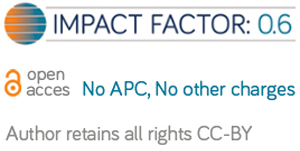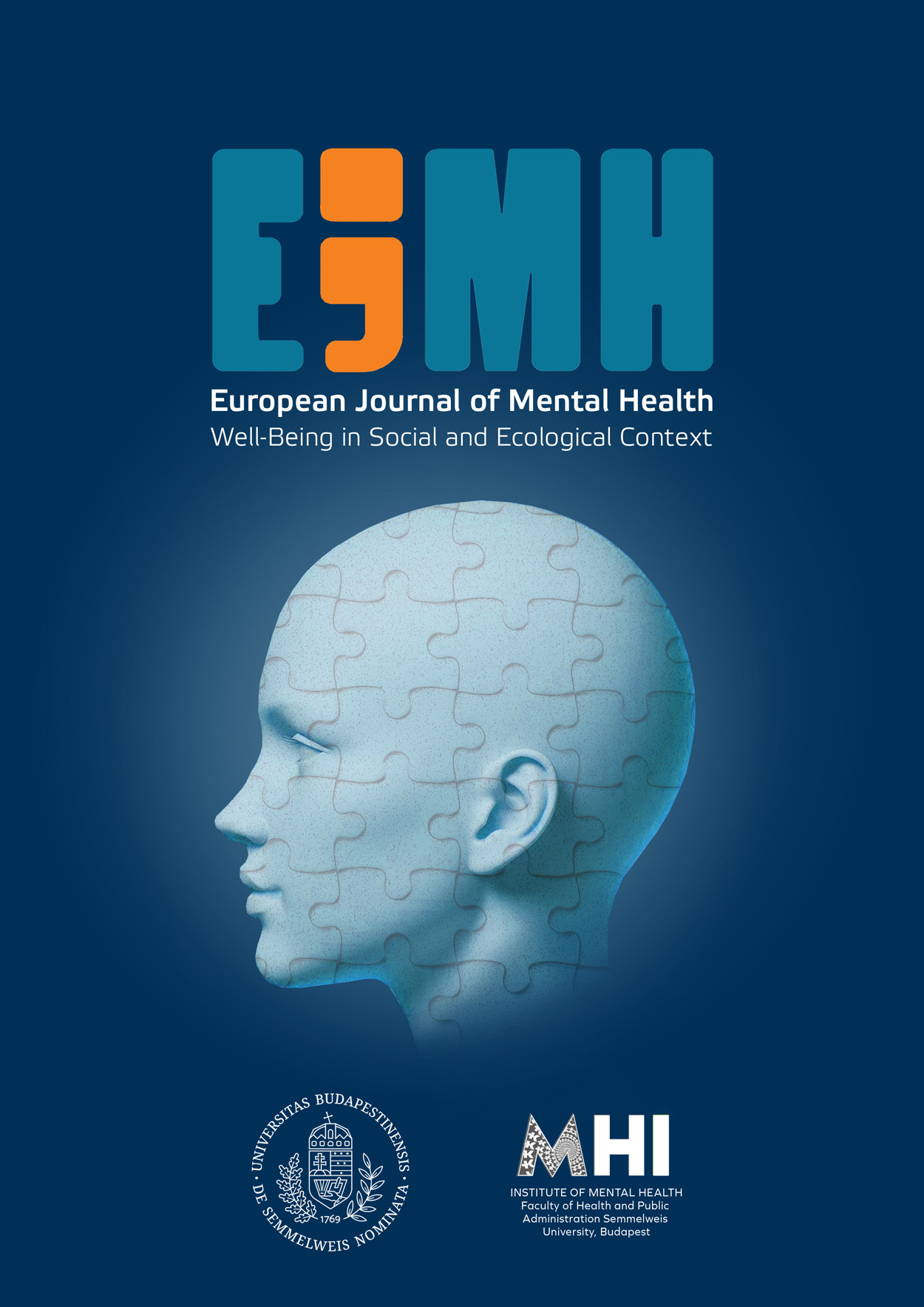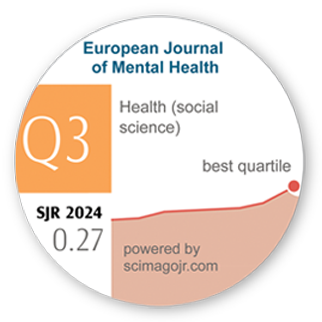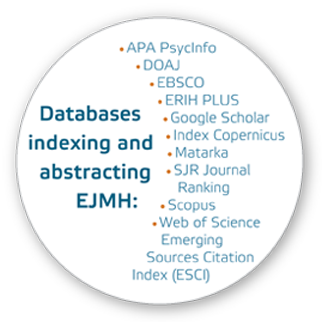Development and Validation of the Hungarian Short ECR-R in a Large Nationally Representative Study and a Large Community Study of Mothers Raising Young Children
DOI:
https://doi.org/10.5708/EJMH.19.2024.0027Keywords:
adult romantic attachment, ECR-R-HU-SF, psychometric parameters, validation, large representative samplesAbstract
Introduction: The Hungarian version of the 36-item self-report Experiences in Close Relationships – Revised (ECR-R-HU) questionnaire assessing adult romantic attachment has been published recently. Short versions provide a useful tool for large-scale research and in the clinical field as well.
Aims: The present study reports developing and validating the short form of the Hungarian version of the ECR-R (ECR-R-HU-SF).
Methods: The development of the short form, data reduction, and item selection were performed in a nationally representative adult (18+) community sample (N = 958; Study 1). The newly developed ECR-R-HU-SF was then tested and validated in a different national study representative of children aged 3–36 months, using data from respondent mothers with diverse sociodemographic backgrounds (N = 980; Study 2).
Results: In Study 1, using randomly split subsamples, the ECR-R-HU-SF retained 8 items and confirmed the original two-factor structure of the measure. The subscales showed very good reliability and correlated highly with their corresponding original long versions. Psychometric properties, construct (convergent) validity, sociodemographic associations, and mean population scores for the short-version subscales (Avoidance, Anxiety) were compared with those of the long version. In Study 2, subscales were highly reliable, and scores correlated in the expected directions with related constructs (depressive mood, perceived stress).
Conclusions: In summary, the ECR-R-HU-SF is a valid instrument that can be used as an effective screening tool for measuring adult romantic attachment.
References
Avsar, A. S. (2022). Comparing the automatic item selection procedure and exploratory factor analysis in determining factor structure. Participatory Educational Research, 9(2), 416–436.
https://doi.org/10.17275/per.22.47.9.2
Bartholomew, K., & Horowitz, L. M. (1991). Attachment styles among young adults: A test of a four-category model. Journal of Personality and Social Psychology, 61(2), 226–244.
https://doi.org/10.1037//0022-3514.61.2.226
Beck, A. T., Ward, C. H., Mendelson, M., Mock, J., & Erbaugh, J. (1961). An inventory for measuring depression. Archives of General Psychiatry, 4(6), 561–571.
https://doi.org/10.1001/archpsyc.1961.01710120031004
Bergin, C., & Bergin, D. (2009). Attachment in the classroom. Educational Psychology Review, 21(2), 141–170.
https://doi.org/10.1007/s10648-009-9104-0
Birnie, C., Joy McClure, M., Lydon, J. E., & Holmberg, D. (2009). Attachment avoidance and commitment aversion: A script for relationship failure. Personal Relationships, 16(1), 79–97.
https://doi.org/10.1111/j.1475-6811.2009.01211.x
Booth‐LaForce, C., & Roisman, G. I. (2014). The adult attachment interview: Psychometrics, stability and change from infancy, and developmental origins: I. Introduction. Monographs of the Society for Research in Child Development, 79(3), 1–14.
https://doi.org/10.1111/mono.12110
Bowlby, J. (1969/1982). Attachment and loss: Vol. 1. Attachment. Basic Books.
Bowlby, J. (1973). Attachment and loss: Vol. 2. Separation: anxiety and anger. Basic Books.
Bowlby, J. (1988). A secure base: Parent-child attachment and healthy human development. Basic Books.
Brenk-Franz, K., Ehrenthal, J., Freund, T., Schneider, N., Strauß, B., Tiesler, F., Schauenburg, H., & Gensichen, J. (2018). Evaluation of the short form of "Experience in Close Relationships" (Revised, German Version "ECR-RD12") - A tool to measure adult attachment in primary care. PLoS One, 13(1), Article e0191254.
https://doi.org/10.1371/journal.pone.0191254
Brennan, K. A., Clark, C. L., & Shaver, P. R. (1998). Self-report measurement of adult attachment: An integrative overview. In J. A. Simpson & W. S. Rholes (Eds.), Attachment theory and close relationships (pp. 46–76). The Guilford Press.
Browne, M. W., & Cudeck, R. (1992). Alternative ways of assessing model fit. Sociological Methods & Research, 21(2), 230 – 258.
https://doi.org/10.1177/0049124192021002005
Calvo, V., D’Aquila, C., Rocco, D., & Carraro, E. (2022). Attachment and well-being: Mediatory roles of mindfulness, psychological inflexibility, and resilience. Current Psychology, 41(5), 2966–2979.
https://doi.org/10.1007/s12144-020-00820-2
Cameron, J. J., Finnegan, H., & Morry, M. M. (2012). Orthogonal dreams in an oblique world: A meta-analysis of the association between attachment anxiety and avoidance. Journal of Research in Personality, 46(5), 472–476.
https://doi.org/10.1016/j.jrp.2012.05.001
Chistopolskaya, K. A., Mitina, O. V., Enikolopov, S., Nikolaev, E., Semikin, G. I., Chubina, S. A., Ozol, S., & Drovosekov, S. (2018). Adaptation on a Russian sample of the short version of Experience in Close Relationships-Revised Questionnaire. Psikhologicheskii Zhurnal, 39(5), 87–98.
https://doi.org/10.31857/S020595920000838-7
Cohen, S., Kamarck, T., & Mermelstein, R. (1983). A global measure of perceived stress. Journal of Health Social Behavior, 24(4), 385–396.
https://doi.org/10.2307/2136404
Conradi, H. J., Kamphuis, J. H., & de Jonge, P. (2018). Adult attachment predicts the seven-year course of recurrent depression in primary care. Journal of Affective Disorders, 225, 160–166.
https://doi.org/10.1016/j.jad.2017.08.009
Danis, I., Bóné, V., Hegedüs, R., Pilinszky, A., Szabó, T., & Dávid, B. (2020). Infancy in 21st century Hungary – A project introduction: Policy, theoretical and methodological framework and objectives of the first national representative parent survey on infant and early childhood mental health. European Journal of Mental Health, 15(2), 111–144.
https://doi.org/10.5708/EJMH.15.2020.2.3
Danis, I., Gervai, J., Tóth, I., Kurimay, T., & Török, S. (2022, September 7–10). Validation and psychometric properties of the Family Assessment Device in Hungary [Poster Presentation]. 11th Conference of the European Family Therapy Association - Systemic Resonances and Interferences, Ljubljana, Slovenia.
Danis, I. Lakatos, K., Ney, K., Tóth, I., & Gervai, J. (2005). A szölői és a tágabb családi környezet kérdőíves vizsgálatának lehetőségei [Measuring parental and broader family environment by questionnaires]. Alkalmazott Pszichológia, 7, 59–74.
Davis, D., Shaver, P. R., & Vernon, M. L. (2003). Physical, emotional, and behavioral reactions to breaking up: The roles of gender, age, emotional involvement, and attachment style. Personality and Social Psychology Bulletin, 29(7), 871–884.
https://doi.org/10.1177/0146167203029007006
Diener, E., & Seligman, M. E. P. (2002). Very happy people. Psychological Science, 13(1), 81–84.
https://doi.org/10.1111/1467-9280.00415
Doll, E. A. (1917). A Brief Binet-Simon Scale. Psychological Clinic, 11(7), 197–211.
Dupont, K., Gervai, J., Danis, I., Tóth, I., Koren, R., & Török, S. (2022). Factor structure, psychometric properties, and validation of the Hungarian version of the Experiences in Close Relationships Revised (ECR-R-HU) Questionnaire in a nationally representative community sample. Journal of Personality Assessment, 104(6), 747–758.
https://doi.org/10.1080/00223891.2021.2019054
Dupont, K., Gervai, J., Tóth, I., Török, Sz., Danis, I. (2023a, March 30- April 1). Measuring adult romantic attachment in Hungary. The Hungarian short version of the Experiences in Close Relationships-Revised (ECR-R-HU): Results of a nationally representative community sample [Poster presentation]. 31st World Family Therapy Congress. Malaga, Spain.
Dupont, K., Török, Sz., Gervai, J., Tóth, I., Danis, I. (2023b, July 15-19). Validation of the Hungarian short ECR-R among mothers of infants in a nationally representative sample [Poster presentation]. 18th World Congress for the World Association for Infant Mental Health, Dublin, Ireland.
Ehrenthal, J. C., Zimmermann, J., Brenk-Franz, K., Dinger, U., Schauenburg, H., Brähler, E., & Strauß, B. (2021). Evaluation of a short version of the Experiences in Close Relationships-Revised Questionnaire (ECR-RD8): Results from a representative German sample. BMC Psychology, 9(1), Article 140.
https://doi.org/10.1186/s40359-021-00637-z
Epstein, N. B., Baldwin, L. M., & Bishop, D. S. (1983). The McMaster Family Assessment Device. Journal of Marital and Family Therapy, 9(2), 171–180.
https://doi.org/10.1111/j.1752-0606.1983.tb01497.x
Esbjørn, B. H., Breinholst, S., Niclasen, J., Skovgaard, L. F., Lange, K., & Reinholdt-Dunne, M. L. (2015). Identifying the best-fitting factor structure of the Experience of Close Relations -Revised in a Scandinavian example. PLoS One, 10(9), Article e0137218.
https://doi.org/10.1371/journal.pone.0137218
Fairchild, A. J., & Finney, S. J. (2006). Investigating validity evidence for the Experiences in Close Relationships-Revised Questionnaire. Educational and Psychological Measurement, 66(1), 116–135.
https://doi.org/10.1177/0013164405278564
Fraley, R. C., Heffernan, M. E., Vicary, A. M., & Brumbaugh, C. C. (2011). The experiences in close relationships – Relationship Structures Questionnaire: A method for assessing attachment orientations across relationships. Psychological Assessment, 23(3), 615–625.
https://doi.org/10.1037/a0022898
Fraley, R. C., Waller, N. G., & Brennan, K. A. (2000). An item response theory analysis of self-report measures of adult attachment. Journal of Personality and Social Psychology, 78(2), 350–365.
https://doi.org/10.1037/0022-3514.78.2.350
Galdiolo, S., & Roskam, I. (2017). Development of attachment orientations in response to childbirth: A longitudinal dyadic perspective. Personality and Individual Differences, 108, 136–143.
https://doi.org/10.1016/j.paid.2016.12.016
Gervai, J., Dupont, K., Tóth, I., Török, S., & Danis, I. (2019). Tapasztalatok szoros kapcsolatokban kérdőív – átdolgozott, rövidített változat (ECR-R-HU-SF) [The short form of the Hungarian version of the Experiences in Close Relationships – Revised (ECR-R-HU-SF)]. The Hungarian translation manuscript.
https://www.ttk.hun-ren.hu/kpi/wp-content/uploads/sites/4/2024/09/Tapasztalatok-Szoros-Kapcsolatokban-rovid-valtozat-ECR-R-HU-SF.pdf
Gervai, J., Tóth, I., Török, S., Koren, R., & Danis, I. (2018). Tapasztalatok szoros kapcsolatokban kérdőív - átdolgozott változat (ECR-R-HU) [The Hungarian version of the Experiences in Close Relationships – Revised version (ECR-R-HU)]. The Hungarian translation manuscript.
https://www.ttk.hun-ren.hu/wp-content/uploads/kpi-modszer/Tapasztalatok_Szoros_Kapcsolatokban_ECR-R-HU.pdf
Graham, J. M., & Unterschute, M. S. (2015). A reliability generalization meta-analysis of self-report measures of adult attachment. Journal of Personality Assessment, 97(1), 31–41.
https://doi.org/10.1080/00223891.2014.927768
Halmai, Z., Dömötör, E., Balogh, G., Sárosi, A., Faludi, G., Székely, A. (2008). Egy új hangulati kérdőív validálása egészséges mintán [Validation of a new mood questionnaire on healthy sample]. Neuropsychopharmacologia Hungarica, 10(3), 151–157.
Hamilton, E., & Carr, A. (2016). Systematic review of self-report family assessment measures. Family Process, 55(1), 16–30.
https://doi.org/10.1111/famp.12200
Hanak, N., & Dimitrijevic, A. (2013). A Serbian version of modified and revised Experiences in Close Relationships Scale (SM-ECR-R). Journal of Personality Assessment, 95(5), 530–538.
https://doi.org/10.1080/00223891.2013.778271
Hazan, C., & Shaver, P. (1987). Romantic love conceptualized as an attachment process. Journal of Personality and Social Psychology, 52(3), 511–524.
https://doi.org/10.1037//0022-3514.52.3.511
Hind, B., Soussi Noufail, O. (2022). Principal component analysis applied to survey data: Methodological aspects and application. International Journal on Optimization and Applications, 2(2), 25–33.
Hu, L.-t., & Bentler, P. M. (1999). Cutoff criteria for fit indexes in covariance structure analysis: Conventional criteria versus new alternatives. Structural Equation Modeling: A Multidisciplinary Journal, 6(1), 1–55.
https://doi.org/10.1080/10705519909540118
Jansen, N., Kühl, J., Eller, N., Kingdon, P., & Firk, C. (2023). Mentalizing capacity partially mediates the relationship between attachment and stress, depression, and anxiety in social work students. Clinical Social Work Journal, 51, 339–353.
https://doi.org/10.1007/s10615-023-00882-2
Kaščáková, N., Husárová, D., Hašto, J., Kolarčik, P., Poláčková Šolcová, I., Madarasová Gecková, A., & Tavel, P. (2016). Validation of a 16-item short form of the Czech version of the Experiences in Close Relationships Revised Questionnaire in a representative sample. Psychological Reports, 119(3), 804–825.
https://doi.org/10.1177/0033294116667725
Kim, S.-H., Sherry, A. R., Lee, Y.-S., & Kim, C.-D. (2011). Psychometric properties of a translated Korean adult attachment measure. Measurement and Evaluation in Counseling and Development, 44(3), 135–150.
https://doi.org/10.1177/0748175611409842
Kumar, R. M. (2022). Assessing the psychometric properties of Hindi version of Experiences in Close Relationships – Revised (ECR-R) Scale. Indian Journal of Forensic Medicine & Toxicology, 16(4), 402–406.
https://doi.org/10.37506/ijfmt.v16i4.18651
Lee, J.-y., Kim, Y.-K., & Shin, Y.-J. (2023). Validation of the Korean version of Culturally Responsive Experiences in Close Relationships–Short Form. International Journal for the Advancement of Counselling, 45(1), 57–81.
https://doi.org/10.1007/s10447-023-09503-6
Lubiewska, K., Głogowska, K., Mickiewicz, K., Wojtynkiewicz, E., Izdebski, P., & Wiśniewski, C. (2016). Skala Experience in Close Relationships-Revised: Struktura, rzetelność oraz skrócona wersja skali w polskiej próbie. Psychologia Rozwojowa, 21(1), 49–63.
https://doi.org/10.4467/20843879PR.16.004.4793
Luhmann, M., Orth, U., Specht, J., Kandler, C., & Lucas, R. E. (2014). Studying changes in life circumstances and personality: It's about time. European Journal of Personality, 28(3), 256–266.
https://doi.org/10.1002/per.1951
Meuti, V., Aceti, F., Giacchetti, N., Carluccio, G. M., Zaccagni, M., Marini, I., Giancola, O., Ciolli, P., & Biondi, M. (2015). Perinatal depression and patterns of attachment: A critical risk factor? Depression Research and Treatment, 2015, Article 105012.
https://doi.org/10.1155/2015/105012
Mikulincer, M., & Shaver, P. R. (2016). Attachment in adulthood: Structure, dynamics and change. (2nd ed.). The Guilford Press.
Moss, E., & St-Laurent, D. (2001). Attachment at school age and academic performance. Developmental Psychology, 37(6), 863–874.
https://doi.org/10.1037//0012-1649.37.6.863
Müller, S., Spitzer, C., Flemming, E., Ehrenthal, J. C., Mestel, R., Strauß, B., & Lübke, L. (2024). Measuring change in attachment insecurity using short forms of the ECR-R: Longitudinal measurement invariance and sensitivity to treatment. Journal of Personality Assessment, 106(2), 218–229.
https://doi.org/10.1080/00223891.2023.2238816
Ravitz, P., Maunder, R., Hunter, J., Sthankiya, B., & Lancee, W. (2010). Adult attachment measures: A 25-year review. Journal of Psychosomatic Research, 69(4), 419–432.
https://doi.org/10.1016/j.jpsychores.2009.08.006
Reio, T. G., Marcus, R. F., & Sanders-Reio, J. (2009). Contribution of student and instructor relationships and attachment style to school completion. The Journal of Genetic Psychology, 170(1), 53–72.
https://doi.org/10.3200/GNTP.170.1.53-72
Rholes, W. R., Simpson, J. A., Blakely, B. S., Lanigan, L., & Allen, E. A. (1997). Adult attachment styles, the desire to have children, and working models of parenthood. Journal of Personality, 65(2), 357-385.
https://doi.org/10.1111/j.1467-6494.1997.tb00958.x
Rotaru, T.-Ș., & Rusu, A. (2013). Psychometric properties of the Romanian version of Experiences in Close Relationships-Revised Questionnaire (ECR-R). Procedia - Social and Behavioral Sciences, 78, 51–55.
https://doi.org/10.1016/j.sbspro.2013.04.249
Schindler, I., Fagundes, C. P., & Murdock, K. W. (2010). Predictors of romantic relationship formations: Attachment style, prior relationships, and dating goals. Personal Relationships, 17(1), 97–105.
https://doi.org/10.1111/j.1475-6811.2010.01255.x
Schreiber, J. B. (2021). Issues and recommendations for exploratory factor analysis and principal component analysis. Research in Social and Administrative Pharmacy, 17(5), 1004–1011.
https://doi.org/10.1016/j.sapharm.2020.07.027
Simpson, J. A., & Campbell, L. (Eds.). (2013). The Oxford handbook of close relationships. Oxford University Press.
https://doi.org/10.1093/oxfordhb/9780195398694.001.0001
Simpson, J. A., & Rholes, W. S. (2019). Adult attachment orientations and well-being during the transition to parenthood. Current Opinion in Psychology, 25, 47–52.
https://doi.org/10.1016/j.copsyc.2018.02.019
Simpson, J. A., Steven Rholes, W., Campbell, L., & Wilson, C. L. (2003). Changes in attachment orientations across the transition to parenthood. Journal of Experimental Social Psychology, 39(4), 317–331.
https://doi.org/10.1016/S0022-1031(03)00030-1
Smith, G. T., & McCarthy, D. M. (1995). Methodological considerations in the refinement of clinical assessment instruments. Psychological Assessment, 7(3), 300–308.
https://doi.org/10.1037/1040-3590.7.3.300
Smith, G. T., McCarthy, D. M., & Anderson, K. G. (2000). On the sins of short-form development. Psychological Assessment, 12(1), 102–111.
https://doi.org/10.1037//1040-3590.12.1.102
Staccini, L., Tomba, E., Grandi, S., & Keitner, G. I. (2015). The evaluation of family functioning by the family assessment device: A systematic review of studies in adult clinical populations. Family Process, 54(1), 94–115.
https://doi.org/10.1111/famp.12098
Stauder, A., & Konkolÿ Thege, B. (2006). Az észlelt stressz kérdőív (PSS) magyar verziójának jellemzői [Characteristics of the Hungarian version of the Perceived Stress Scale (PSS)]. Mentalhigiéné és Pszichoszomatika, 7(3), 203–216.
https://doi.org/10.1556/Mental.7.2006.3.4
Susánszky, É., Konkoly-Thege, B., Stauder, A., & Kopp, M. (2006). A WHO Jól-lét Kerdőív rövidített (WBI-5) magyar változatának validálása a Hungarostudy 2002 országos lakossági egészségfelmérés alapján [Validation of the short (5-item) version of the WHO Well- Being Scale based on a Hungarian representative health survey, Hungarostudy 2002]. Mentalhigiéné és Pszichoszomatika, 7(3), 247–255.
https://doi.org/10.1556/Mental.7.2006.3.8
Švecová, J., Kaščáková, N., Fürstová, J., Hašto, J., & Tavel, P. (2021). Validation of the 14-item short form of the Slovak version of the Experiences in Close Relationships Revised Questionnaire. Československá Psychologie, 65(2), 146–162.
https://doi.org/10.51561/cspsych.65.2.146
Thompson, G., Wrath, A., Trinder, K., & Adams, G. C. (2018). The roles of attachment and resilience in perceived stress in medical students. Canadian Medical Education Journal, 9(4), e69–e77.
Topp, C. W., Østergaard, S. D., Søndergaard, S., & Bech, P. (2015). The WHO-5 Well-Being Index: A systematic review of the literature. Psychotherapy and Psychosomatics, 84(3), 167–176.
https://doi.org/10.1159/000376585
Treboux, D., Crowell, J. A., & Waters, E. (2004). When "new" meets "old": Configurations of adult attachment representations and their implications for marital functioning. Developmental Psychology, 40(2), 295–314.
https://doi.org/10.1037/0012-1649.40.2.295
Wei, M., Russell, D. W., Mallinckrodt, B., & Vogel, D. L. (2007). The Experiences in Close Relationship Scale (ECR)-Short Form: Reliability, validity, and factor structure. Journal of Personality Assessment, 88(2), 187–204.
https://doi.org/10.1080/00223890701268041
WHO (1998). Wellbeing measures in primary health care /the DepCare Project: Report on a WHO meeting: Stockholm, Sweeden, 12–13 February 1998. WHO Regional Office for Europe.
https://iris.who.int/handle/10665/349766
Wilkinson, R. B. (2011). Measuring attachment dimensions in adolescents: Development and validation of the Experiences in Close Relationships – Revised – General Short Form. Journal of Relationships Research, 2(1), 53–62.
https://doi.org/10.1375/jrr.2.1.53
Wongpakaran, N., Wongpakaran, T., Lerttrakarnnon, P., Jiraniramai, S., Saisavoey, N., Tantrarungroj, T., Satthapisit, S., DeMaranville, J., Myint, K. M., & Wedding, D. (2023). Psychometric assessment of the 10-item, revised experience of close relationship (ECR-R-10) in nonclinical and clinical populations of adults and older adults in Thailand. Scientific Reports, 13, Article 14969.
https://doi.org/10.1038/s41598-023-41306-y
Wongpakaran, T., & Wongpakaran, N. (2012). A short version of the revised ‘Experience of Close Relationships Questionnaire’: Investigating non-clinical and clinical samples. Clinical Practice and Epidemiology in Mental Health, 8, 36–42.
https://doi.org/10.2174/1745017901208010036
Wongpakaran, T., Wongpakaran, N., & Wannarit, K. (2011). Validity and reliability of the Thai version of the Experiences of Close Relationships-Revised Questionnaire. Singapore Medical Journal, 52(2), 100–106.
Zigmond, A. S., & Snaith, R. P. (1983). The Hospital Anxiety and Depression Scale. Acta Psychiatrica Scandinavica, 67(6), 361–370.
https://doi.org/10.1111/j.1600-0447.1983.tb09716.x






